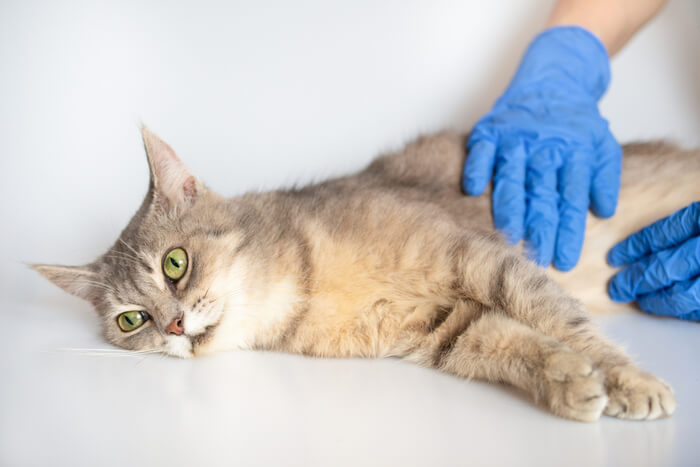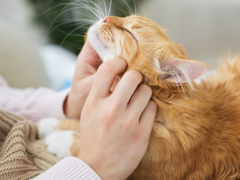
Salmonellosis is an infection with the bacterium Salmonella. It can cause sickness in any animal or human through ingestion of material (usually food or water) that has been contaminated with feces. Cats infrequently become ill unless they have a suppressed immune system but can transmit the disease.
Here are a few things to know if you think your cat has Salmonellosis.
Quick Overview: Salmonella in Cats
 Other Names: Salmonellosis
Other Names: Salmonellosis
 Common Symptoms: Fever, lethargy, poor appetite, diarrhea, vomiting, blood or mucus in stool, enlarged lymph nodes, abnormal vaginal discharge.
Common Symptoms: Fever, lethargy, poor appetite, diarrhea, vomiting, blood or mucus in stool, enlarged lymph nodes, abnormal vaginal discharge.
 Diagnosis: If Salmonella is suspected based on symptoms, feces can be cultured to detect Salmonella. Polymerase chain reaction (PCR) testing may also be done.
Diagnosis: If Salmonella is suspected based on symptoms, feces can be cultured to detect Salmonella. Polymerase chain reaction (PCR) testing may also be done.
 Requires Ongoing Medication: No
Requires Ongoing Medication: No
 Vaccine Available: No
Vaccine Available: No
 Treatment Options: Antibiotics, intravenous fluids, hospitalization. Severely ill cat may require advanced care.
Treatment Options: Antibiotics, intravenous fluids, hospitalization. Severely ill cat may require advanced care.
 Home Remedies: None
Home Remedies: None
What Is Salmonella?
Salmonella is a rod-shaped gram-negative genus of bacteria under the Enterobacteriaceae family. There are two species of Salmonella, S. enterica and S. bongori which are further divided into six subspecies and over two thousand serotypes.
Salmonella can cause disease in mammals (including humans), birds, and reptiles and can be a real public health concern in all parts of the world.
What Are the Signs and Symptoms of Salmonella in Cats?

The symptoms of salmonella in cats (salmonellosis) depend on whether your cat suffers from enteritis or a systemic septicemia, a form of blood poisoning.
Illness from salmonellosis (disease caused by Salmonella), is most often found to be enteritis or a systemic septicemia, also known as typhoid.
Enteritis is inflammation and infection of the intestinal tract, where the Salmonella bacteria invade the intestines and cause gastrointestinal disease, this can also be referred to as gastroenteritis when the stomach and small intestines are involved.
Septicemia is a blood infection, also known as blood poisoning, when the bacteria enters the blood stream and spreads throughout the body. There are other less common illnesses caused by Salmonella such as respiratory infections, meningitis, abortions, and arthritis.
The most common type of infection is actually known as the carrier state. This is where the infected animal carries large amounts of the bacteria in their gastrointestinal tract and sheds the bacteria in their feces, but they don’t show any signs of sickness from it. This is commonly known as an asymptomatic carrier. The carrier state is the state in which the disease is most commonly spread to other animals.
Salmonellosis is cats is actually quite rare.
Most commonly, a cat infected with Salmonella is in the carrier state and doesn’t show sickness but can spread it. The cats who become sick with Salmonella typically have a suppressed immune system with illnesses such as the Feline Leukemia Virus or Feline Immunodeficiency Virus, or others.
Kittens who have been exposed to a large amount of the bacteria are also more predisposed to Salmonella infection because their immune systems aren’t fully developed.
Enteritis
The most common sign in cats with Salmonella enteritis, is diarrhea. The diarrhea sometimes contains blood or mucus. These cats can also be lethargic, have a fever, vomit, become anorexic, have abdominal pain, lose weight, and can become dehydrated with prolonged diarrhea or simply not drinking enough water due to an upset stomach.
Septicemia
Cats with the septicemic form of Salmonella are typically lethargic, have a fever, are anorexic, have pale mucus membranes, have an increased heart rate and respiratory rate, and can go into shock. These cats sometimes have swollen lymph nodes as well as gastrointestinal signs.
How Do You Diagnose Salmonella in Cats?
If a cat is thought to have Salmonellosis, they should be seen right away by a veterinarian.
Most of the time the cat presents with vague symptoms such as chronic diarrhea or any of the other symptoms mentioned above. A veterinarian will perform a physical examination which may or may not be normal, depending on the state of the disease.
To know for sure if a cat has Salmonella, the bacteria must be isolated and identified by a culture and sensitivity test. The bacteria can be cultured from the blood, urine, bone marrow, or spinal fluid, but is most commonly isolated from the feces of infected animals. Once the bacteria is grown in the lab, a specificity test can be run to determine which antibiotics the bacteria is susceptible to for accurate and efficient treatment.
How to Test for Salmonella in Cats?
A PCR (polymerase chain reaction) test can also be used to identify the Salmonella bacteria.
Other tests such as blood work might show abnormalities secondary to the septicemia or enteritis caused by the bacteria. It may show signs of dehydration, infection, inflammation, anemia, or organ failure.
How Do You Treat Salmonella in Cats?

Cat receiving subcutaneous fluids, a common treatment for fluid loss as a result of diarrhea.
Antibiotic Therapy
Many veterinarians don’t use antibiotics to treat Salmonellosis in cats, especially if the cat is an asymptomatic carrier or has mild gastrointestinal disease. Antibiotic use can contribute to the resistance of the bacteria and worse infections.
Antibiotic therapy is typically reserved for extremely sick cats with systemic infections and those that are immunocompromised. The type of antibiotic is selected based on the culture test results and by what antibiotic the isolated bacteria is susceptible to.
Supportive Care
Supportive care is selected based on what clinical signs the cat has from the Salmonella infection and how sick the cat is. It is very important that the sick cat is kept well hydrated with fluids, especially if they have diarrhea.
Hydration
In mild cases treated on an outpatient basis, the fluids are given subcutaneously (under the skin). In severe cases with systemic disease or septicemia, the cat is hospitalized and started on intravenous fluids, intravenous antibiotics, and sometimes a plasma or blood transfusion is needed for those cats that have septicemia.
Nausea Control
Anti-nausea medications are used if the cat is vomiting and a bland, low fat diet that is easy on the stomach should be fed. Mild cases have a good prognosis and can be treated on an outpatient basis at home. Severe cases requiring hospitalization or those cats that are immunocompromised tend to have a poorer prognosis.
How Do Cats Get Salmonella?

Cats may become infected with salmonella by ingesting food, water, or soil that was contaminated with infected feces.
Cat become infected with Salmonella through the fecal-oral route of infection. This means the cat ingests food, water, or soil that has become contaminated with feces infected by Salmonella.
This is more commonly known as food poisoning or a food-borne illness when a cat becomes sick from eating contaminated food.
One of the most significant risk factors for salmonellosis in cats occurs when a cat is fed a raw cat food diet, specifically raw meat.
The Center for Disease Control (CDC) has found in studies, that 25% of raw pet food samples were found to be tested positive for harmful bacteria such as Salmonella. It is because of this risk of food poisoning from Salmonella and other harmful pathogens, that most veterinarians do not recommend a raw food diet for cats.
Because cats are most commonly asymptomatic carriers, an infected can with Salmonella can infect humans, who are more susceptible to illness from Salmonella. This is referred to as a zoonotic pathogen when it can be transmitted between pets and people.
A less likely form of transmission of Salmonella is through the air into the respiratory tract.
Frequently Asked Questions
How do I know if my cat has Salmonella?
A common clinical sign of Salmonellosis in cats is diarrhea, but since cats are most often asymptomatic carriers of Salmonella, it is very likely that you would not know if your cat has the bacteria. If you cat has chronic or recurrent diarrhea, the feces can be cultured to see if the Salmonella bacteria is isolated, which would confirm the infection.
If you have an immunocompromised cat or a young kitten in an unsanitary environment, they will be more prone to getting a Salmonella infection. A cat sick with Salmonella might have diarrhea, lethargy, anorexia, weight loss, vomiting, or other systemic effects. If your cat eats a raw food diet and has these symptoms, that greatly increases the likelihood that they have Salmonella food poisoning.
How is Salmonella treated in cats?
Salmonella is only treated with antibiotics in immunocompromised cats, cats with systemic disease, or sick young kittens. In mild infections with gastrointestinal symptoms, antibiotics are not used, instead supportive care is given.
Supportive care could include such treatments as intravenous or subcutaneous fluids to rehydrate the cat, anti-nausea medications to treat the vomiting, and a low-fat bland diet to support the gastrointestinal tract.
Can cats spread Salmonella?
Yes, cats can spread Salmonella. As asymptomatic carriers, cats might act completely normal and healthy but still shed the Salmonella bacteria in their feces which could contaminate or infect other animals or people. Salmonellosis is a zoonotic disease meaning it can spread from animals to people and vice versa.
What is Salmonella poisoning in cats?
Salmonella poisoning in cats is caused by an infection with the bacteria Salmonella. A cat typically gets Salmonella poisoning from eating food or drinking water that has been contaminated with infected feces. The most common cause is from feeding a raw food diet which is more likely to be contaminated.
Can Salmonella kill cats?
It would be unlikely for a Salmonella infection to cause death in a cat. However, if the cat has a poor immune system from a virus, disease, other illness, or if it is a young kitten that has been exposed to a large amount of bacteria, it would be more likely for it to have a severe form of the disease and death would be a significant and real risk. In most cats, the disease is self-limiting and resolves on its own or with basic supportive care.








My two year old kitty died from eating her food. Before she died her back l back legs were paralyzed. She was meowing loudly in pain and she hardly ever meows. After she died, foamy bubbles came from her nose and mouth and I smelled her canned cat food on her breath. She and my other cat were vomiting for 2 days before it happened but not a lot. They were both drinking a lot of water the night before the little one died. She was my emotional support kittie and I’m so heartbroken. I called Purina and filed a report. I’m taking my other cat to the vet to get her tested. Does this sound like they ate something toxic?
Hello Susan, thank you so much for sharing this experience. I’m so sorry to hear that your cat died, especially in such a shocking way. I’m not a veterinarian, but these symptoms absolutely sound like they are associated with poisoning, and the fact that both cats were showing similar symptoms suggests that it was most likely linked to something both of them ate or were exposed to. You’re doing the right thing by filing a report and getting your second cat tested. I hope everything works out, and please keep us updated.
Thank you, Mallory. I had one vet tell me it was her heart and another said it couldn’t be from the food she ate. I know she was poisoned and I’m going to order a test kit for salmonella.
Google “Feline Distemper”